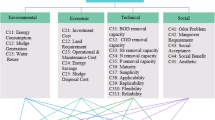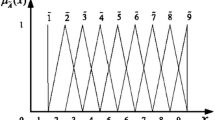Abstract
Cyanobacteria blooms and toxins released from cyanobacteria, called cyanotoxins, have become a serious environmental issue because of their potential toxicity toward human health. Several conventional and advanced water treatment methods are available for degradation of cyanotoxins from surface water, but a cost-effective and efficient water treatment technique can greatly reduce the processing time and improve the quality of treated water. Selection of an optimum treatment technique for cyanotoxins degradation is a multi-criteria decision-making problem owing to the involvement of several conflicting criteria and constraints. In this paper, an integrated Fuzzy-ELECTRE model was proposed and its potential toward evaluation of different cyanotoxins removal techniques has been explored to select the most suitable technology. In this integrated model, criteria importance weights were determined by Fuzzy process, while the ranking of alternatives was performed using ELECTRE process. The result obtained from the model shows that ‘advanced oxidation by titanium dioxide \({({\rm TiO}_{2})}\)’ is the most suitable technology among all considered technology for the removal of cyanotoxins. The developed methodological approach was also used to rank the available treatment techniques within the main group of conventional and advanced oxidation methods (AOMs). The results clearly depict that ozonation and photocatalysis by \({{\rm TiO}_{2}}\) are the best methods within the group of conventional and AOMs, respectively. The ability of the proposed model for providing complete and clear ranking of all considered alternatives confirms its potential for evaluation of cyanotoxins removal methods.
Similar content being viewed by others
References
Metcalf, J.S.; Codd, G.A.: Cyanobacterial Toxins in the Water Environment: A Review of Current Knowledge. Foundation for Water Research (2004)
Chorus I., Bartram J.: Toxic Cyanobacteria in Water: A Guide to their Public Health Consequences, Monitoring, and Management. E & FN Spon, London (1999)
Codd G.A., Morrison L.F., Metcalf J.S.: Cyanobacterial toxins: risk management for health protection. Toxicol. Appl. Pharmacol. 203, 264–272 (2005)
Pantelić D., Svirčev Z., Simeunović J., Vidović M., Trajković I.: Cyanotoxins: characteristics, production and degradation routes in drinking water treatment with reference to the situation in Serbia. Chemosphere 91, 421–441 (2013)
Metcalf J.S., Richer R., Cox P.A., Codd G.A.: Cyanotoxins in desert environments may present a risk to human health. Sci. Total Environ. 421, 118–123 (2012)
Westrick J.A., Szlag D.C., Southwell B.J., Sinclair J.: A review of cyanobacteria and cyanotoxins removal/inactivation in drinking water treatment. Anal. Bioanal. Chem. 397, 1705–1714 (2010)
Zamyadi A., McQuaid N., Prévost M., Dorner S.: Monitoring of potentially toxic cyanobacteria using an online multi-probe in drinking water sources. J. Environ. Monit. 14, 579–588 (2012)
Merel S., Clément M., Thomas O.: State of the art on cyanotoxins in water and their behaviour towards chlorine. Toxicon 55, 677–691 (2010)
Gutie’rrez-Praena D., Pichardo S., Jos A., Moreno F.J., Camean A.M.: Biochemical and pathological toxic effects induced by the cyanotoxin Cylindrospermopsin on the human cell line Caco-2. Water Res. 46, 1566–1575 (2012)
Zamyadi A., Dorner S., Sauvé S., Ellis D., Bolduc A., Bastien C., Prévost M.: Species-dependence of cyanobacteria removal efficiency by different drinking water treatment processes. Water Res. 47, 2689–2700 (2013)
Dai G., Quan C., Zhang X., Liu J., Song L., Gan N.: Fast removal of cyanobacterial toxin microcystin-LR by a low-cytotoxic microgel-Fe (III) complex. Water Res. 46, 1482–1489 (2012)
Nishiwaki-Matsushima R., Ohta T., Nishiwaki S., Suganuma M., Kohyama K., Ishikawa T., Carmichael W.W., Fujiki H.: Liver tumor promotion by the cyanobacterial cyclic peptide toxin microcystin-LR. J. Cancer Res. Clin. 118, 420–424 (1992)
Zhou L., Yu H., Chen K.: Relationship between microcystin in drinking water and colorectal cancer. Biomed. Environ. Sci. 15, 166–171 (2002)
WHO: Cyanobacterial Toxins: Microcystin-LR. Guidelines for Drinking-Water Quality, pp. 95–110. World Health Organization, Geneva (1998)
Merel S., Walker D., Chicana R., Snyder S., Baurès E., Thomas O.: State of knowledge and concerns on cyanobacterial blooms and cyanotoxins. Environ. Int. 59, 303–327 (2013)
Ho L., Tanis-Plant P., Kayal N., Slyman N., Newcombe G.: Optimising water treatment practices for the removal of Anabaena circinalis and its associated metabolites, geosmin and saxitoxins. J. Water Health 7, 544–556 (2009)
Falconer I.R.: Cyanobacterial Toxins of Drinking Water Supplies: Cylindrospermopsins and Microcystins. CRC, Boca Raton (2005)
Fawell J.K., Mitchell R.E., Everett D.J., Hill R.E.: The toxicity of cyanobacterial toxins in the mouse: I microcystin-LR. Hum. Exp. Toxicol. 18, 162–167 (1999)
Van Apeldoorn M.E., Van Egmond H.P., Speijers G.J., Bakker G.J.: Toxins of cyanobacteria. Mol. Nutr. Food Res. 51, 7–60 (2007)
Kao, C.Y.: Paralytic shellfish poisoning. In: Falconer, C.Y. (ed.) Algal Toxins in Seafood and Drinking Water, pp. 75–86. Academic Press, London (1993)
Silva de Assis, H.C.; da Silva, C.A.; Oba, E.T.; Pamplona, J.H.; Mela, M.; Doria, H.B.; Guiloski, I.C.; Ramsdorf, W.; Cestari, M.M.: Hematologic and hepatic responses of the freshwater fish Hoplias malabaricus after saxitoxin exposure. Toxicon 66, 25–30 (2011)
Cruz, A.de la; Antoniou, M.; Hiskia, A.; Pelaez, M.; Song, W.; OShea, K.; He, X.; Dionysiou, D.: Can we effectively degrade microcystins? Implications on human health. Anti-Cancer Agents Med. Chem. 11, 19–37 (2011)
Sharma, V.K.; Triantis, T.M.; Antoniou, M.G.; He, X.; Pelaez, M.; Han, C.; Song, W.; O’Shea, K.E.; de la Cruz, A.; Kaloudis, T.; Hiskia, A.; Dionysiou, D.D.: Destruction of microcystins by conventional and advanced oxidation processes: a review. Sep. Purif. Technol. 91, 3–17 (2012)
Maghsoudi E., Fortin N., Greer C., Duy S.V., Fayad P., Sauvé S., Prévost M., Dorner S.: Biodegradation of multiple microcystins and cylindrospermopsin in clarifier sludge and a drinking water source: effects of particulate attached bacteria and phycocyanin. Ecotoxicol. Environ. Saf. 120, 409–417 (2015)
Hatami-Marbini A., Tavana M., Moradi M., Kangi F.: A Fuzzy group Electre method for safety and health assessment in hazardous waste recycling facilities. Saf. Sci. 51, 414–426 (2013)
Kaya T., Kahraman C.: An integrated Fuzzy AHP–ELECTRE methodology for environmental impact assessment. Expert Syst. Appl. 38, 8553–8562 (2011)
Beccali M., Cellura M., Mistretta M.: Decision-making in energy planning. Application of the Electre method at regional level for the diffusion of renewable energy technology. Renew. Energy 28, 2063–2087 (2003)
Roy B.: The outranking approach and the foundations of ELECTRE methods. Theor. Decis. 31, 49–73 (1991)
Sevkli M.: An application of the Fuzzy ELECTRE method for supplier selection. Int. J. Prod. Res. 48, 3393–3405 (2010)
Rouyendegh B.D., Erkan T.E.: An application of the Fuzzy electre method for academic staff selection. Hum. Factors Ergon. Manuf. Serv. Ind. 23, 107–115 (2013)
Giannoulis C., Ishizaka A.: A web-based decision support system with ELECTRE III for a personalised ranking of British universities. Decis. Support Syst. 48, 488–497 (2010)
Montazer G.A., Saremi H.Q., Ramezani M.: Design a new mixed expert decision aiding system using Fuzzy ELECTRE III method for vendor selection. Expert Syst. Appl. 36, 10837–10847 (2009)
Raj P.A.: Multicriteria methods in river basin planning—a case study. Water Sci. Technol. 31, 261–272 (1995)
Buchanan J., Vanderpooten D.: Ranking projects for an electricity utility using ELECTRE III. Int. Trans. Oper. Res. 14, 309–323 (2007)
Özcan T., Çelebi T., Çelebi N., Esnaf Ş.: Comparative analysis of multi-criteria decision making methodologies and implementation of a warehouse location selection problem. Expert Syst. Appl. 38, 9773– (2011)
Hatami-Marbini, A.; Tavana, M.: An extension of the Electre I method for group decision-making under a Fuzzy environment. Omega 39, 373‒386 (2011)
Figueira J., Greco S., Ehrgott M.: Multiple Criteria Decision Analysis: State of the Art Surveys, vol. 78. Springer, New York (2005)
Chang P.C., Liu C.H.: A TSK type Fuzzy rule based system for stock price prediction. Expert Syst. Appl. 34, 135–144 (2008)
Zadeh L.A.: Fuzzy sets. Inf. Control 8, 338–353 (1965)
Bellman R.E., Zadeh L.A.: Decision-making in a Fuzzy environment. Manag. Sci. 17, B141–B164 (1970)
Dubois D., Prade H.: Operations on Fuzzy numbers. Int. J. Syst. Sci. 9, 613–626 (1978)
Kaufmann A., Gupta M.M.: Introduction to Fuzzy Arithmetic: Theory and Applications. Van Nostrand Reinhold, New York (1991)
Wang T.C., Chang T.H.: Application of TOPSIS in evaluating initial training aircraft under a Fuzzy environment. Expert Syst. Appl. 33, 870–880 (2007)
Vlad S., Anderson W.B., Peldszus S., Huck P.M.: Removal of the cyanotoxin anatoxin-a by drinking water treatment processes: a review. J. Water Health 12, 601–617 (2014)
Ghernaout B., Ghernaout D., Saiba A.: Algae and cyanotoxins removal by coagulation/flocculation: a review. Desalin. Water Treat. 20, 133–143 (2010)
Shi H., Ding J., Timmons T., Adams C.: pH effects on the adsorption of saxitoxin by powdered activated carbon. Harmful Algae 19, 61–67 (2012)
Teixeira M.R., Rosa M.J.: Neurotoxic and hepatotoxic cyanotoxins removal by nanofiltration. Water Res. 40, 2837–2846 (2006)
Oberholster P.J., Botha A.M., Grobbelaar J.U.: Microcystis aeruginosa: source of toxic microcystins in drinking water. Afr. J. Biotechnol. 3, 159–168 (2004)
Onstad G.D., Strauch S., Meriluoto J., Codd G.A., von Gunten, U.: Selective oxidation of key functional groups in cyanotoxins during drinking water ozonation. Environ. Sci. Technol. 41, 4397–4404 (2007)
Author information
Authors and Affiliations
Corresponding author
Rights and permissions
About this article
Cite this article
Debnath, A., Majumder, M. & Pal, M. Potential of Fuzzy-ELECTRE MCDM in Evaluation of Cyanobacterial Toxins Removal Methods. Arab J Sci Eng 41, 3931–3944 (2016). https://doi.org/10.1007/s13369-016-2032-7
Received:
Accepted:
Published:
Issue Date:
DOI: https://doi.org/10.1007/s13369-016-2032-7




